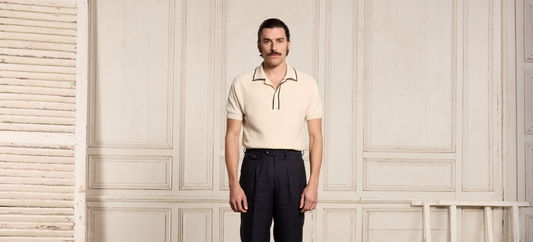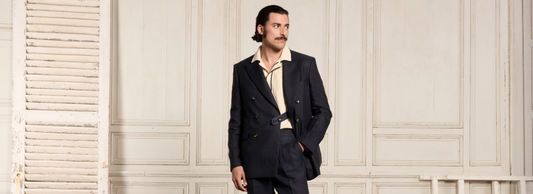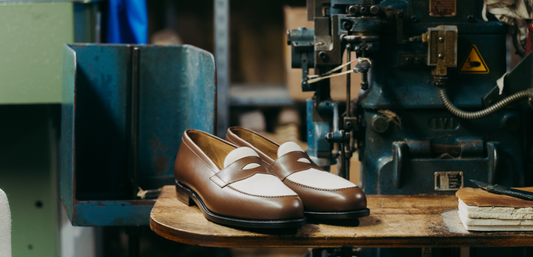It was July 1919 when the publisher Maxwell Perkins agreed to publish the first novel by a certain Francis Scott Fitzgerald. The Other Side of Paradise appeared a few months later and, at the same time as that of its hero Amory Blaine, paints the portrait of a disoriented youth, drowning out the traumatic memory of the Great War in jazz and drunkenness. From the first chapter, readers of the man who will become the leader of the Lost Generation discover a word that no one had yet put down on paper: “T shirt”.

The story of an icon
Behind the anecdote, there is a historical reality that we believe is important to relate to introduce the history of this piece which has become cult . Indeed, it was on the shoulders of the American military that the T-shirt as we know it today experienced its first hours of glory. Inspired by the wool flannel undershirts favored by the British navy, the US Navy developed a short-sleeved cotton knit and decided to make it the official undergarment of its uniforms in 1913. Back grandson of medieval nightgowns and grandson of Long John or Union Suit type jumpsuits, this round neck knit will easily find its name thanks to its famous “T” shape.
At this time, the T-shirt was still only an item of underwear, and sailors needed hierarchical authorization to wear it on deck without a jacket or shirt. It was only at the end of the War that he returned to dry land at the same time as the soldiers, and that the latter began to wear him as is. It will only take a handful of weeks for athletes and young people to see the full potential of this piece, and even less for Fitzgerald to integrate it into the wardrobe of his hero leaving for Princeton.
Throughout the first half of the 20th century, brands like Hanes, Sears and Fruit of the Loom fought for control of this promising market, trying by all means to change the “underwear” image of the t-shirt, widely anchored in the minds.

Even more than advertising, it was (again) the war that allowed the “tee” to become legendary. Definitely this time. On the backs of the GIs, and supported by intense war propaganda, he embodies in the eyes of the world a certain idea of American power and victorious America.

This front page, particularly daring for the time, clearly contributed to the emancipation of the t-shirt as well as to its inclusion in a composite imagination: quiet strength, triumphant masculinity, American way of life etc.
As soon as the world conflict ended, it was – as is often the case – the cinema which would bring this garment to the pinnacle. In a similar register, he will dazzle the whole world on the shoulders of Montgomery Clift ( A Place in the Sun, 1951 ), Marlon Brando ( The Wild Team, 1953 ) and even James Dean ( The Fury of Living, 1955 ).

Ambiguous and enigmatic, prodigal son of pajamas and military uniforms, admirable for some and indecent for others, the t-shirt thus obtained the status of an item in its own right in the 50s and 60s. Tolerated more than admitted, it stands out as an “ outershirt ” (or “outer garment”) and is thus visible to all.
In the open air, it unleashes its full potential and appears as a real space of expression that brands, organizations and collectives are eager to occupy. Immediately after its consecration, it becomes a communication medium: electoral campaigns, political demands, protest slogans, marketing operations, humorous messages, everything is an excuse for personalization and the plain t-shirt quickly gives way to its screen-printed counterpart. Added to its iconic design is a dimension of appropriation and personal expression, which further adds to the record of this knitting like no other.

Born from the obvious union of comfort and functionality , the t-shirt can be considered a total piece. In 110 years of existence - in its contemporary form at least, it has indeed carried out all the functions, to the point of becoming the very symbol of a sector prey to frenzy. Underwear and combat gear, sports clothing and undershirt, marketing object and symbol of protest, rallying power and social marker, dyed, faded, printed or embroidered, worked by ultra fast-fashion as well as by the biggest luxury houses, it has established itself over the decades as the best-selling basic on the planet.
More closely linked than any other to that of the textile industry, the trajectory of the t-shirt reveals an exponential boom and the excesses systematically associated with it: relocation motivated by profit, lack of traceability, use of cheap raw materials ( synthetic and/or poor quality), human exploitation, depletion of natural and energy resources, pollution of soil, water and atmosphere, etc.
Today more than ever, the t-shirt embodies the most beautiful face of clothing , as well as its darkest side. The cornerstone of any wardrobe and emblem of consumerist madness, sold in billions of copies each year, it seems capable of the best and the worst, which is why Hast has been busy defending its honor. And yours at the same time.
Anatomy of the T-shirt
You have understood, a t-shirt is a short-sleeved knit whose “T” shape gave it its name. That being said, several elements can vary from one t-shirt to another, so that it is difficult to find two identical ones:
- The material : first in wool then in cotton , the contemporary t-shirt can count on a wide choice of fibers to dress its fabric. On an industry scale, polyester and cotton are in a good position, but linen, hemp, merino, ramie and other artificial fibers (lyocell or viscose) allow us to imagine alternatives and interesting mixes. At Hast, we only work with natural raw materials , which is why organic cotton and linen are our favorites.

- The cut : historically close to the body, the t-shirt has not been confined to its role as an undershirt and has allowed itself, through the ages, some experiments in terms of volume. So we have seen it sometimes wide and loose (in the 90s in particular), sometimes slim and long. For our part, we preferred to stay faithful to its most classic and harmonious proportions: a straight cut falling perfectly on the hips , effective in the pants as well as outside.
- The collar : rectangular for Royal Navy sailors, round for the American Navy, V-shaped on occasion, everything (or almost) is possible on a t-shirt in terms of collar. By adjusting its shape, its notch and its construction, it is possible to obtain more or less original results to vary the registers. On our racks, however, you will not find anything extravagant or eccentric: our collars are round , perfectly proportioned and assembled with the greatest care . In our humble opinion, this is absolutely the best elegance-comfort-versatility ratio.
- The length of the sleeves : just take a look at the photo of Marlon Brando to be convinced, the sleeves of the period were spectacularly short. They went far above the biceps and displayed a rather unsightly curvature. Considering that it was then a piece that was worn under other clothes, we do not find much to complain about, but we must recognize that this design would be unwelcome today. Too short or too long, the sleeves of the t-shirt tend to deconstruct the silhouette (just as the bar of the “T” cannot reasonably grow or shrink without offending the eye). From then on, you will see that ours stop more or less at mid-biceps, which seems to us to be the ideal length .
- The assembly : unlike a shirt, a t-shirt is knitted (and not woven) . For this reason, it can optionally be assembled in one piece - without side seams - using special knitting machines. In this case, it is called “ tubular ”. Otherwise, the mesh panels are assembled classically to give the piece its shape, in which case you will find the famous seams on the sides.
- Fantasies : by emancipating itself from the category of underwear, the t-shirt was quick to assert its rights in terms of originality. Screen prints, embroidery, chest pocket: all have found a place in the sun on the most famous of knitwear. At Hast, sobriety and timeless chic are an integral part of our DNA, which is why we build our collections with moderation and temperance. That being said, we are not afraid to dare to take a step aside on occasion, either by inscribing our values at the heart of our t-shirts , or by adding a little extra soul.
- Color : an open secret, advances in dyeing have made it possible to infinitely extend the choice of colors in textiles. Universal clothing if ever there was one, the t-shirt is obviously no exception. From the famous tie & dye hippies to our current color palettes, the love affair between color and this cult piece is not new. At Hast, we work with classic shades and other more daring ones, all using varied know-how. On the one hand, it is difficult to get more natural than our no-dye creations which are simply not dyed . On the other hand, we use different forms of dye to enhance our colored pieces: garment dye consists of dyeing the garment after assembly , which gives it a subtly faded appearance ; while yarn or roll dyeing reveals a much more uniform tone. Depending on the register in which you want to include your outfit, one or the other will certainly have its effect.

The advantages of Hast t-shirts
Of the 100 billion new items of clothing sold each year in the world, the t-shirt often ends up on the top step of the podium. Having become over time a symbol of disposable fashion and hyper-consumption, its unreasonable production is the subject of growing criticism: use of low-end fibers, excessive use of natural resources, pollution of water and soils, exploitation of farmers and workers etc.
Faced with the humanitarian, health and environmental disaster, it was important for us to offer our customers a respectable and responsible alternative. As indicated in our advice article for identifying a quality t-shirt , we have taken care of each step of our production chain to guarantee you a worthy piece in all respects. 100% natural fibers for your health and that of the planet, choice of labeled materials to meet our social and ecological requirements, significant weight for resistance and durability, simple and effective color palette combining no dye and garment dye , guaranteed European manufacturing by craftsmen that we know personally: so many guarantees that will allow you to invest with confidence and conscience. That’s also honesty.
The special case of polo
These days, it would be easy to mistake the polo shirt for a simple T-shirt adorned with a shirt collar. However, their journeys are very different and deserve a moment's attention. Unlike the European roots of the t-shirt, you have to go to India to find those of its counterpart. And more precisely on the polo fields, an elite equestrian sport imported from the steppes of Central Asia. Under the influence of the Maharajah of Jodhpur, players shortened the sleeves and the length of their shirts, sewed buttons to the collar to prevent it from blowing in the wind and invented, almost involuntarily, the "polo shirt".

Repatriated to the Old Continent by British colonists, it was not until the 1920s and a certain Jean-René Lacoste - tennis player - to give it its definitive aesthetic.

In a century, it has not moved a single millimeter, which seems to be the prerogative of legendary pieces.
At Hast, we interpret it in accordance with this legendary itinerary, combining the ease of the t-shirt and the elegance of the shirt. With short sleeves in organic supima cotton or long sleeves in merino wool , there is no doubt that you will find the one you dream of.
Wear the t-shirt in two lessons
Closed parenthesis, let's get back to our t-shirts. As far as we know, there are only two ways to wear them: alone or accompanied.
In the first case, and depending on the desired effect, you can focus on absolute sobriety or on taking a side step. Generally, only summer allows you to wear the t-shirt without escort, which will allow you to vary the pleasures and colors. From the classic (and unmistakable) white model to the more colorful versions, you will just have to try to find your favorite assortment.

In the second case, the range of possibilities is much wider. In this register, the t-shirt regains its former status and plays, as before, the supporting role. That being said, it is not relegated to the rank of underwear stricto sensu , and rather asserts itself as an adjuvant in layering. A way to get noticed discreetly.
By showing the tip of your nose under a shirt and/or a work jacket or a blazer , you will actually show much more than that: a pronounced taste for relaxed elegance, a mastery imbued with nonchalance, the science of casual chic .
The interview question
Like all underwear in direct contact with the skin, the t-shirt is one of those items of clothing that should be washed after each wear. Fortunately, it is a relatively easy part to maintain , which only requires a few precautions. At Hast, we advise you to put your knitting in the machine on the wrong side (to avoid damaging the front in the event of friction) and to limit the spin to 400 or 600 revolutions per minute. Depending on the material of your item, you can opt for a delicate program or not, without exceeding 30°C . To avoid the risk of deformation and limit discoloration, drying should take place flat and away from direct sunlight. For its part, ironing is perfectly possible, provided you choose an appropriate temperature - more or less high depending on whether your clothing is made of linen, cotton or wool. Nothing rocket science, then, but nothing trivial either. Respecting these subtleties can in fact double or even triple the life expectancy of a t-shirt, which is no small thing when we consider that it is the most discarded item on an international scale. .
The final word
Between homage, praise and fashion archeology, together we explored the crazy history of the t-shirt and its interpretation at Hast. A true legend of clothing, it is today the best-selling item in the world , with the good and the bad that this supremacy entails. Faithful to our values of honesty and responsibility , we work on our side worthy and sustainable models with the ambition to clean up its production chain. Timeless designs, noble natural materials , 100% European manufacturing and careful finishing: our t-shirts are all promises of elegance and durability, to allow you to become a legend with complete conscience.






















